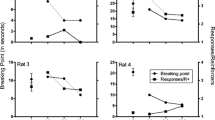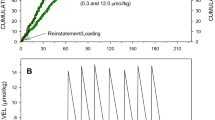Abstract
This study evaluated the effects of chlorpromazine and pimozide on reinforced responding. In each session, rats were exposed to a series of five variable-interval reinforcement schedules. The response requirement was a lever press, the reward was a small portion of water, and the reinforcement rate varied from about 20 to 660 reinforcers per hour. Response rate was a negatively accelerated function of reinforcement rate, and the relationship between the two variables was described by the equation for a rectangular hyperbola (the matching law). One parameter of the hyperbola is equivalent to the asymptotic response rate and the other parameter is equivalent to the rate of reinforcement that maintains a one-half asymptotic response rate. Chlorpromazine (0.75–3.0 mg/kg) and pimozide (0.1–0.4 mg/kg) dose-dependently decreased response rates. At low doses, the response rate decreases were, for the most part, restricted to the low reinforcement rate schedules. In contrast, the highest dose tested decreased response rates at both low and high reinforcement rates. The patterns of response rate decreases resulted in dose-dependent changes in the parameters of the matching law equation. The shifts in the matching law parameters were discussed in terms of the motoric and motivational interpretations of neuroleptic-induced response rate changes.
Similar content being viewed by others
References
Bradshaw CM, Szabadi E, Bevan P (1978) Effect of variable-interval punishment on the behavior of humans in variable-interval schedule of monetary reinforcement. J Exp Anal Behav 29:161–166
Bradshaw CM, Ruddle HV, Szabadi E (1981) Relationship between response rate and reinforcement frequency in variable-interval schedules: III. The effect of d-amphetamine. J Exp Anal Behav 36:29–39
Bradshaw CM, Szabadi E, Ruddle HV (1983a) Herrnstein's equation: Effect of response-force requirement on performance in variable-interval schedules. Behav Anal Lett 3:93–100
Bradshaw CM, Szabadi E, Ruddle HV, Pears E (1983b) Herrnstein's equation: effect of deprivation level on performance in variable-interval schedules. Behav Anal Lett 3:267–273
Conrad DG, Sidman M (1956) Sucrose concentration as reinforcement for lever pressing by monkeys, Psychol Rep 2:381–384
Creese I, Burt DR, Snyder SH (1976) Dopamine receptor binding predicts clinical and pharmacological potencies of antischizophrenic drugs. Science 192:481–483
de Villiers PA, Herrnstein RJ (1976) Toward a law of response strength. Psychol Bull 83:1121–1153
Ettenberg A, Carlisle HJ (1985) Neuroleptic induced deficits in operant responding for temperature reinforcement. Pharmacol Biochem Behav 22:761–767
Ettenberg A, Koob GG, Bloom FE (1981) Response artifact in the measurement of neuroleptic-induced anhedonia. Science 209:357–359
Fibiger HC, Carter DA, Phillips AG (1976) Decreased intracranial self-stimulation after neuroleptics or 6-hydroxydopamine: Evidence for mediation by motor deficits rather than by reduced reward. Psychopharmacology 47:21–27
Franklin KBJ (1978) Catecholamines and self-stimulation: Reward and performance effects dissociated. Pharmacol Biochem Behav 9:813–820
Gallistel CR, Karras D (1984) Pimozide and amphetamine have opposing effects on the reward summation function. Pharmacol Biochem Behav 20:73–77
Geldard FA (1972) The human senses. John Wiley, New York
Gerber GJ, Sing J, Wise RA (1981) Pimozide attenuates lever pressing for water in rats. Pharmacol Biochem Behav 14:201–205
Gramling SE, Fowler SC, Collins KR (1984) Some effects of pimozide on nondeperived rats licking sucrose solutions in an anhedonia paradigm. Pharmacol Biochem Behav 21:617–624
Guttman N (1954) Equal-reinforcement values for sucrose and glucose solutions compared with equal-sweetness values. J Comp Physiol Psychol 47:358–361
Hamilton AL, Stellar JR, Hart EB (1985) Reward, performance, and the response strength method in self-stimulating rats: Validation and neuroleptics. Physiol Behav (in press)
Herrnstein RJ (1970) On the law of effect. J Exp Anal Behav 13:243–266
Herrnstein RJ (1974) Formal properties of the matching law. J Exp Anal Behav 21:159–164
Heyman GM (1983) A parametric evaluation of the hedonic and motoric effects of drugs: pimozide and amphetamine. J Exp Anal Behav 40:113–122
Heyman GM (1985) How drugs affect cells and reinforcement affects behavior: Formal analogies. In: Church RM, Commons M, Stellar JR, Wagner AR (eds) Biological determinants of reinforcement and memory, Lawrence Erlbaum, Hillsdale, New Jersey (in press)
Heyman GM, Coons W (1981) The effects of pimozide on reinforced responding. Abstract: Eastern Psychological Association Meeting, New York
Heyman GM, Seiden LS (1985) A parametric description of amphetamine's effects on response rate: changes in reinforcement efficacy and response topography. Psychopharmacology 85:154–161
Kraeling P (1961) Analysis of amount of reward as a variable in learning. J Comp Physiol Psychol 54:560–565
Logan FA (1960) Incentive, Yale University Press, New Haven
McSweeney FK (1978) Prediction of concurrent key-peck and treadle press responding from simple schedule performance. Anim Learn Behav 6:444–450
Morley MJ, Bradshaw CM, Szabadi E (1984) The effects of pimozide on variable-interval performance: A test of the anhedonia hypothesis of the mode of action of neuroleptics. Psychopharmacology 84:531–536
Mosteller F, Rourke REK, Thomas GB (1972) Probability with statistical applications. Addison-Wesley, Menlo Park
Olds J, Travis RP (1960) Effects of chlorpromazine, meprobamate, pentobarbital and morphine on self-stimulation. J Pharmacol Exp Ther 128:397–404
Scatchard G (1949) The attraction of proteins for small molecules and ions. Ann NY Acad Sci 51:660–672
Tombaugh TN, Tombaugh J, Anisman H (1979) Effects of dopamine receptor blockade on alimentary behaviors: Home cage food consumption, magazine training, and performance. Psychopharmacology 66:219–225
Wetherington CL, Lucas TR (1980) A note on fitting Herrnstein's equation. J Exp Anal Behav 34:199–206
Wise RA (1982) Neuroleptics and operant behavior: The anhedonia hypothesis, Behav Brain Sci 5:39–87
Wise RA, Spindler J, de Wit H, Gerber GJ (1978) Neuroleptic-induced “anhedonia” in rats: pimozide blocks the reward quality of food. Science 201:262–264
Woods PJ, Holland CH (1964) Instrumental escape conditioning in a water tank: Effects of constant reinforcement at different levels of drive stimulus intensity. J Comp Physiol Psychol 62:403–408
Author information
Authors and Affiliations
Additional information
Offprint requests to: G.M. Heyman
Rights and permissions
About this article
Cite this article
Heyman, G.M., Kinzie, D.L. & Seiden, L.S. Chlorpromazine and pimozide alter reinforcement efficacy and motor performance. Psychopharmacology 88, 346–353 (1986). https://doi.org/10.1007/BF00180837
Received:
Revised:
Issue Date:
DOI: https://doi.org/10.1007/BF00180837




